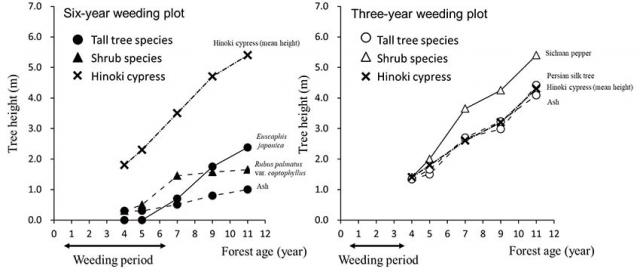Home > Research > Research Results > Research Results 2018 > Effects of shortened weeding period on a Hinoki cypress plantation
Update:June 13, 2018
Main content starts here.
Effects of shortened weeding period on a Hinoki cypress plantation
| Article title |
Effects of Shortened Weeding Period on Colonization of Native Broad-leaved Tree Species in a Hinoki Cypress Plantation |
|---|---|
| Author (affiliation) |
Tomomasa Suzaki (a), Hiroyuki Ando (b), Takashi Masaki (c) (a) Ibaraki District Forest Office, KANTO Regional Forest Office, Mito, Ibaraki, Japan. (c) Forestry and Forest Products Research Institute, Tsukuba, Ibaraki, Japan. |
| Publication Journal |
Journal of the Japanese Forest Society, 100(1):15-19, February 2018, DOI: 10.4005/jjfs.100.15( External link ) |
| Content introduction |
Numerous plantation forests face the need to be cleared and undergo reforestation. In such operations, the most frequently faced problem is the high cost of weeding. For mitigating that cost, the process of weeding may be omitted. For exploring this possibility, the KANTO Regional Forest Office and Forestry and Forest Products Research Institute investigated the growth of planted Hinoki cypress trees and the colonization of native broad-leaved trees when the usual period of weeding was halved. The site investigated in the present study was a forest in Ibaraki Prefecture, which had undergone reforestation after clear cutting of a plantation forest of Hinoki cypress trees, which had been planted on grassland 100 years ago. At 10 to 15 meters away from the edge of a forest comprising Konara oak and ash, we established a plot where weeding would be conducted for a normal period of six years and another plot where weeding would be conducted for only first three years. In these plots, we monitored the growth of trees between the ages of four and 11 for seven years. Consequently, no colonization of Konara oak occurred, irrespective of the length of the weeding period. On the contrary, ash trees whose seeds are dispersed by wind were found frequently in both plots. Regarding the growth of trees, Hinoki cypress trees grew significantly faster than other broad-leaved trees in the six-year weeding plot, whereas the mean height of colonizing broad-leaved trees surpassed that of Hinoki cypress trees in the three-year weeding plot. Furthermore, fast-growing broad-leaved trees were generally shrub species, and tall tree species including ash were suppressed by them. These results suggest that shortening the weeding period may adversely affect the growth of Hinoki cypress. Moreover, the colonization of native broad-leaved tall tree species was hindered despite the proximity of the broad-leaved forest serving as a seed source. These findings will be useful as a reference in deciding whether to shorten the weeding period.
Figure. Comparison of tree height growth between planted Hinoki cypress and colonizing broad-leaved trees in the six-year and three-year weeding plots. This figure shows the mean height of the planted Hinoki cypress seedlings and the growth trajectory of the highest individuals of the dominant tree species comprising the community of colonizing broad-leaved trees. When weeding was conducted over a normal period of six years, the height of the broad-leaved tree community was kept far lower than that of the Hinoki cypress community (left). However, when weeding was conducted only for three years, the mean heights of broad-leaved trees in the broad-leaved tree community became equal to or surpassed the mean height of Hinoki cypress trees, especially with broad-leaved shrub species growing exceptionally tall (right). |
Copyright © Forest Research and Management Organization. All rights reserved.

